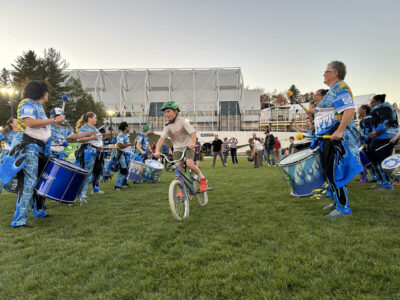An idea may lead to a different idea, may lead to …
During WWII, secret agents alone and inside the Nazi empire, deep under cover, could use an ordinary radio (or newspapers) to listen to coded messages from London or America. Popular music or other shows would end with “And now for a special announcement. The cat is white. I say again, the cat is white.” The cat being white might mean a big counter attack on Tuesday, and so on. But the sleeper agents had no way to send information. The moment an agent would fire up a transmitter, the Nazis could zero in on his (or quite often HER) location using RDF: Radio Direction Finding. This is the same reason today radar systems in the military are the first to die in conflict: by their very nature they are a beacon saying (like a light house on a dark night) “I am here!”
“Quantum Computing” is in the news these days. It got me thinking again about an old kooky idea from high school. I never went beyond high school physics and was lucky I got a passing grade in that. But one problem stuck in my head: how to send information (note: I did not say “transmit”) without being subject to RDF. This problem is not to be confused with “encryption.” Imagine two people standing and talking to each other about 20 feet from you. They are speaking Swahili. You have no idea what they are saying (“encrypted”) but you clearly know where they are (from your eyes and ears locating their exact positions).
Now, imagine if there is someone 100 feet directly to my left and another person 100 feet directly to my right. If I yell “HELP” both will hear me. And the fact that one hears me does not diminish the strength of sound that the other person hears. That is how sound waves work. But that is not how radio waves work (I think … If I remember right). When a single, low power electron/radio wave propagates out it is a probability wave unlike sound or a ripple in a pond. But once it impinges on an antenna it collapses into a physical electron … and thus denies anyone else the opportunity to detect it. The dual nature of wave/particle physics I think it is called (again, high school was almost a half century ago and I was more interested in the well-developed girl sitting in front of me in physics class … so if I get it wrong, bear with me). The key to this idea is radio waves (while similar in other respects) do not work like sound waves when received.
If this idea can work, then imagine a transmitter, say, in Long Island, that sends out a hum at a set frequency (what radio people call CW or continuous wave). A receiver in, say, Washington D.C. is tuned to that frequency and hears the hum (after super-het I.F. stages, etc). All well and good. The strength of the hum stays the same. If an additional receiver located anyplace tunes into that frequency and receives the signal, then the strength of the signal received in Washington will be less. Unlike sound, the second receiver will affect the receiver in Washington’s signal strength. When that extra someone turns off there radio (front end diodes as mixers not withstanding) and stops receiving, the signal strength (“S” value in radio parlance) in Washington will go back up. Morse code. Serial Digital communication. A.S.K. (Amplitude Shift keying). And so on.
So … in theory … the “extra receiver” can send intelligence with out pushing watts of transmitted power. Just turn the extra receiver on and off. If this could work, it would be very difficult to RDF (emissions from I.F. transformer cans, crystal oscillators, etc in a receiver and such not withstanding). It also means no super-duper technology is needed (mostly). There is a lot more to think about: multi-path, CMEs and so on … this is just an idea. It might even be possible to “pull” the frequency off with another receiver and see the “intelligence” as FM … I don’t know.
I emailed this idea to the physics department at Brooklyn College (where I managed to finish a bachelors degree in the 1980’s to the shock of my parents and disgust of the facility) a decade ago. The guy said it was interesting but might not be practical.
To be honest, if this idea was worthwhile someone would have done it long ago. BUT … the experiment itself might pique the interest of some current student/future Nobel Prize winner from the Tri-Lakes. If a high school science teacher made this setup with the class, then perhaps one student may say: “Hmmm … yeah, it’s a bust. But what if we changed this right here …” Charlie Sporck, while not a Nobel Prize winner, was from Saranac Lake.
So that’s my rant. Might this little idea lead to other things from better minds than mine? I think it would be a fun project to do for a physics class and maybe, just maybe, one student would find inspiration for a life’s work in physics.
Just a thought. … and … Can you hear me now?
— — —
Ira Weinberg lives in Saranac Lake.

